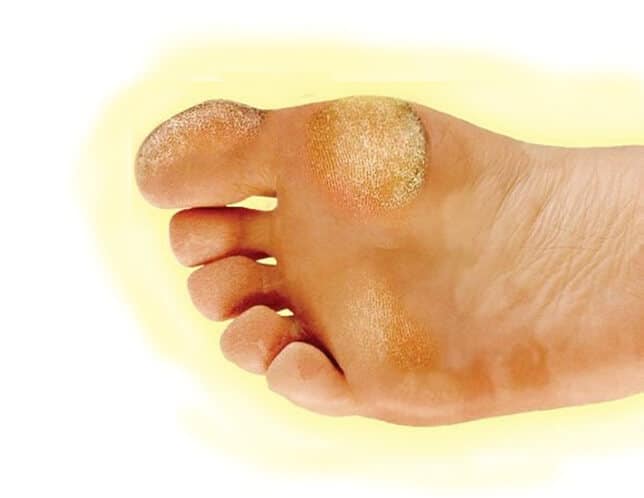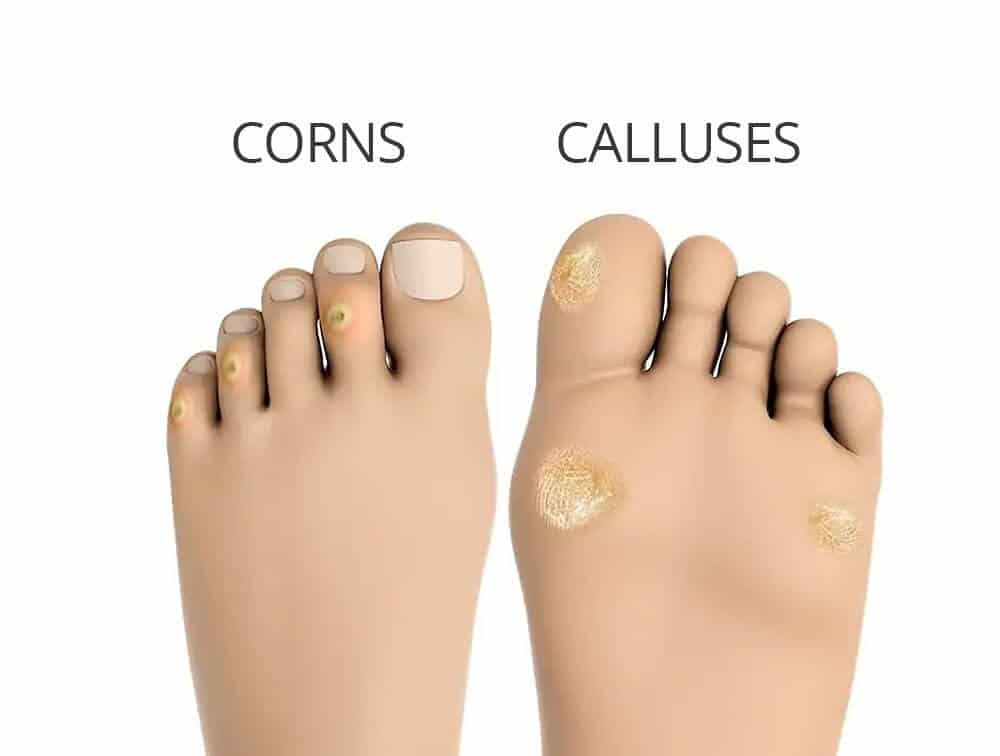Corns and calluses are the results of the development of hard, thick skin. Even though these hardened patches of skin can appear anywhere on your body, they are most commonly found on your feet, hands, or fingers. Let’s take a deeper look into what is Corn and Calluses and what are their types, symptoms, and core causes.

Corns
Corns are typically tiny and round. Corns are most commonly found on the tops or sides of your toes. Corns come in a variety:

- Hard corns: Hard corns are tiny, hard, thick patches of skin that are generally seen inside a broader area of hardened skin. Hard corns typically occur on the tops of toes, where bone pressure rubs against the skin.
- Soft corns: They are whitish/gray in color and have a softer, rubbery feel. Between the toes, soft corns develop.
- Seed corns: These are tiny corns that grow on the bottoms of feet.
Corns form on the top (hard corns), sides (soft corns), and bottom (seed corns) of your toes and feet.
Calluses

Calluses are dense, hard patches of skin. Calluses are bigger and more random in shape than corns. Calluses are more likely to appear on the bottom of your foot in bony regions that bear your weight, such as your heel, big toe, ball of your foot, and down the side of your foot. It is typical to have some callus development on the bottom of your foot.
Calluses on the hands are also common. Calluses, for example, occur when there is repetitive contact or rubbing, such as on the tips of guitar players’ fingers or the hands of gymnasts, weightlifters, or artisans.
Calluses form on your feet’ weight-bearing regions.
How Do Corns And Calluses Form?
Corns and calluses form as a result of frequent friction, rubbing, or irritation, as well as pressure on the skin. Corns and calluses often develop on the bony or visible parts of the foot. Calluses are more prone to occur on the hands in regions where there is constant rubbing against the skin.
Corns and calluses are thickened layers of skin that your body develops to protect the underlying skin from pain and irritation.
What Causes Calluses?
Corns and calluses form and grow as a result of pressure and friction from repetitive activities. Among the origins of this pressure and friction are:
- Wearing shoes that are too small: Tight shoes and high heels can cause regions of your foot to collapse. When your footwear is excessively loose, your foot may slip and brush against the shoe on a regular basis. Your foot may even come into contact with a seam or stitch within the shoe.
- Socks are being removed: Wearing shoes and sandals without socks might create foot friction. Socks that don’t fit correctly might also be an issue.
- Long periods of standing, walking, or running
- Standing on your feet: Physical hobbies, sports, or jobs that require you to stand on your feet.
- Having socks or shoe linings that slide and bunch up beneath your feet when you’re wearing shoes.
- Walking incorrectly, such as walking too hard on the inner or outside border of your foot.
- Playing an instrument or working with hand tools. Calluses on your hands can develop as a consequence of repetitive pressure when playing an instrument, using hand tools, or even writing.
Who is more prone to developing corns or calluses?
If you have a history of corns or calluses, you are more prone to develop them.
- You already have medical problems that change the natural alignment of your feet ‘ bones. For example, foot arthritis, bunions, bone spurs, or hammertoes.
- You have one or more of the corns and calluses described in this page.
- You move around without socks.
- You’re wearing shoes that are too small for your feet.
- You are a smoker.
Is it painful to have corn and calluses?
Corns and calluses could be painful or not. Sometimes corn and calluses may not be severe at first but become painful as they grow over time.
Sensitivity to touch or pressure can occur in raised regions of skin, particularly corns. Calluses are less sensitive to touch than the skin around them. Fissures, or cracks, can occur in a callus. Fissures may be extremely unpleasant. If you have infected corn or callus, you will most likely experience irritation.
What are the risks of having corns and calluses?
Corns and calluses that have not been treated or have been unsuccessfully treated may increase in size until the root cause is addressed.
Calluses and corns can get infected. This can be extremely uncomfortable and make walking difficult. You may require medical or surgical treatment.
Symptoms
If you see any of the following activities, you may have a corn or a callus:
- Skin hardening occurs when there is repetitive friction or pressure on the skin (corns and calluses).
- A little, round and hardened skin bump covered by irritated skin (more likely to be a corn).
- Thick, rigid, and generally bigger and more flattened patch of skin (more likely to be callus).
- Touch sensitivity is lower than that of the surrounding skin (more likely to be callus).
- The bump’s raised region may be uncomfortable (more likely to be corn).
- Blisters, pain, and redness.
Does A Callus Have A Root?
The main thing is that corns do not have roots. Many people think they have and It is a popular misconception.
The reason it continues is that corn frequently reappears after we have removed them.
They return since the cause of the corn is still present. The only method to prevent corn from returning is to find out the cause. Simply removing corn does not eliminate the root cause.
The cause of the high pressure could be due to a hammertoe pushing on tight fitting shoes, for instance, it could be between the toes and the alignment of the toes is slightly off, causing pressure on the point where the corn develops; or it could be due to the shoe pushing on a bunion.
If the corn is to be kept from returning, the reason for the corn must be discovered and removed. The reason for the pressure will influence how that pressure is released.
Was it the toe’s shape? Is there any enlarged bone? Is it possible that the shoes do not fit properly?
Once that has been determined, help may be offered on the best method to eliminate or reduce that pressure in order to keep them from returning.
What Does A Foot Callus Feel Like?
Certain corn or calluses may not be unpleasant if they form early, but later become painful as they harden over time. The elevated skin regions particularly of corn might be painful or touch-sensitive. Calluses are likely to be less sensitive than their regular skin.
Read: How to remove calluses from foot permanently
Can calluses cause problems?
Calluses are typically not a great concern, but they might become an issue with the appropriate scenario or underlying condition.
Calluses are too thick to be cured in severe situations at home and should be treated by a podiatrist. Often they cause the redistribution of weight, or they may get infected, specifically if they shatter.
What might be the worst thing?
Calluses can grow excessively thick and dry, causing them to break up and even bleed.
Diabetes:
This might be a concern for someone with general good health, but it could spin out of control incredibly fast for someone with diabetes and lead to the need for amputation. If a callus grows too thick, rips open and becomes infected, or becomes an ulcer, a diabetic patient may be disastrous.
See your podiatrist instantly whether your feet cause your difficulties if you have diabetes.
Problems caused by calluses are uncommon, but still possible, for people without diabetes.
People whose calluses break and get infected are at the highest risk. The infection can spread to the bone or blood, which can lead to sepsis or blood poisoning once your blood is contaminated. It might be deadly if this continues untreated.
Throat Cancer:
Hard foot skin and calluses are already irritating, but scientists have discovered a new cause to be concerned about the thickness of your soles: calluses are related to cancer.
According to a recent study, certain calluses are caused by a hereditary type of esophageal cancer rather than shoe rubbing and other skin irritation.
Queen Mary University of London researchers discovered that a kind of cancer known as Tylosis causes swelling of the soles of the feet and palms of the hands. In severe situations, patients are required to shave off multiple layers of hard skin with a razor in order to keep the thickness under control.
How Tylosis Cancer Causes Calluses?
The researchers discovered that the gene responsible for the illness Tylosis, iRHOM2, influences the body’s development of keratin, one of the most common elements of the skin, which can lead to skin thickening.
Other symptoms of esophageal cancer, which affects thousands of people in the United States and Europe, tend to involve trouble swallowing, back and stomach pain or discomfort, continuous or frequent heartburn, loss of appetite, weight loss, and nausea.
It is important to keep in mind, though, that not all hand and foot calluses are cancer signs.
Read: How to remove deep calluses from the bottom of your feet
What happens if a callus is left untreated?
Please contact your podiatrist immediately if you feel your calluses are irregular or accompanied by severe complications such as those in the following list:
- Swelling
- Sensitivity or pain as you walk or stand
- Fever
- Cracking of the skin
- Pain
- Fluid or Pus
- Discoloration
Are Calluses Itchy?
In many situations, calluses are itchy. The blood itself is an irritant, acting as a foreign body within the callus, causing the region to burn or itch. Infection may occur if the blood pool is exposed to the outside environment.
It may also not be itchy, but it may feel rough to the touch. It’s also vital to remember not to trim or shave your calluses.
By cutting too deeply into the skin, you risk injuring the tissue in your foot. Cutting too deeply into your skin might potentially result in an infection.
Do calluses go away?
Yes, the majority of calluses are temporary and may be treated at home.
Is it usual for calluses to wipe away?
Wearing shoes that are well-fitting and have plenty of space around the toes. This helps reduce the discomfort that was the source of the problem in the first place. The corns or calluses will naturally diminish over time. This process might take several weeks or months.
Read: How to prevent and avoid calluses
How long do calluses last?
When you quit doing the action that causes the callus to form, it should go away in a couple of months. Workers’ calluses and guitar-playing calluses, in certain situations, penetrate deep into the layers of your skin and may never completely disappear.
Calluses and corn are typically not serious health issues. They typically go away with time, although in extreme cases, this might take months or even years.
Final Words
Calluses can be produced by a number of activities, and they are often neither unpleasant nor permanent.
Using home treatments to soften your skin, clean the area, and hydrate your hands will usually work to eliminate the callus gradually.
If your painful or itchy calluses do not disappear after home therapy, you should consult a dermatologist about alternative treatment options.

